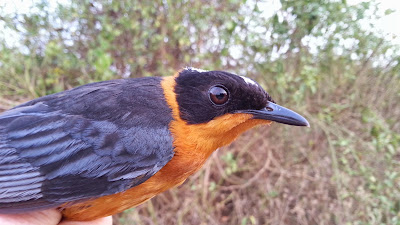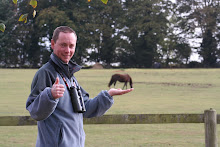The first site was called Mpanga Forest. As the name suggests, it was a forest site and we were ringing along the edge of the woodland. It was relatively quiet for ringing, with a small number of lovely birds, but it was a welcome change of pace and eased us into the ringing gently as the initial 10 days of our tour had been very intense. The habitat at Mpanga where we chose to site the nets was forest edge and nets were erected the night before and were safe in-situ until we left. We only ringed a small number of birds but it did give us the opportunity to look at the different feather wear and moult strategy of different species. Although we didn't get to catch many birds, the ones we did were smart. White throated greenbul, red crowned robin chat, olive sunbird, green twinspot, green hylia and yellow throated tinkerbirds were all ringed during the two days.
Our next site was called Lutembe Bay, the complete opposite to Mpanga. The area had sadly been degraded from when Roger first stared ringing there with much of the scrub being cleared for new developments but there was still several areas where we could ring. Due to the number of people and animals in the area, the nests could be left up and had to be erected every morning. ot too bad a job with three of us. and nets were erected in the dark on both mornings. Habitat was relatively open scrubby bush, with small trees and swamp/marsh nearby. Our recce when we arrived showed that there were lots of birds about including several species of weaver and plenty of palearctic migrants. We were excited when dawn came and we got the nets up.
Over the four days ringing at the two sites we handled well over 100 birds of 43 different species, crazy but a great experience.
The first net round was truly unbelievable for the number and variety of birds, with weavers, sunbirds, bee-eaters, kingfishers and a stack of other birds, many resident and also a good number of migrants heading north.
If Carlsberg did net rounds, then then I'm sure they did this one!!
There were so many highlights over the two days. At least 5 species of weaver, red cheeked cordon-bleu, didric cuckoo, 2 species of kingfisher and bee-eater and 3 species of sunbird to name a few.
Also interesting to see were these very stocky reed warblers, whinchat and tree pipit, all on the move north with good fat scores. It was also good to catch some of the very pale grey willow warblers that were of one of the eastern races. In the field they confused me to start off with their plumage tones and dark legs but the biometrics said willow warbler not chiffchaff.
There were so many highlights over the two days. At least 5 species of weaver, red cheeked cordon-bleu, didric cuckoo, 2 species of kingfisher and bee-eater and 3 species of sunbird to name a few.
Also interesting to see were these very stocky reed warblers, whinchat and tree pipit, all on the move north with good fat scores. It was also good to catch some of the very pale grey willow warblers that were of one of the eastern races. In the field they confused me to start off with their plumage tones and dark legs but the biometrics said willow warbler not chiffchaff.
Over the four days ringing at the two sites we handled well over 100 birds of 43 different species, crazy but a great experience.
Roger has been working to establish a permanent ringing scheme in Uganda and it would be excellent to see his work continue and especially the development of the young Ugandan ringers has been training.
Pic 1 - white throated greenbul
Pic 2 - grey backed cameroptera
Pic 3 - yellow throated tinkerbird
Pic 4 - red crowned robin chat
Pic 5 - olive sunbird
Pic 6 - green hylia
Pic 7 - red chested sunbird
Pic 8 - common waxbill
Pic 9 - African pigmy kingfisher
Pic 10 - blue breasted bee-eater
Pic 11 - didric cuckoo
Pic 12 - green headed sunbird
Pic 13 - copper sunbird
Pic 14 - snowy crowned robin chat
Pic 15 - willow warbler
Pic 16 - whinchat
Pic 17 - grey capped warbler
Pic 18 - black headed gonolek
Pic 19 - red cheeked cordon bleu
Pic 20 - yellow whiteeye





















No comments:
Post a Comment